Abstract
This study aimed to determine the appropriate steam treatment conditions, using a steam nursery cabinet, to break the dormancy of Japanese rice cultivar seeds exhibiting various dormancy levels. The influence of the temperature and duration of the steam treatments on the germination percentage and germination rate was investigated. In highly dormant ‘Takanari’ seeds, the steam treatment at 40 °C for 7 d increased the germination percentage and decreased the 50% germination time (T50S; based on seed number); this treatment was as effective as the dry heat treatment at 50 °C for 7 d. For the medium dormant ‘Moeminori’ and ‘Hitomebore’ seeds, the steam treatment at 40 °C for 5 d decreased T50S sufficiently and more effectively than did the dry heat treatment at 50 °C for 7 d. For the slightly dormant ‘Moeminori’ seeds, the steam treatment at temperatures ranging from 24 °C to 40 °C for 7 d decreased T50S without a corresponding decrease in germination percentage to <90%. For the non-dormant ‘Moeminori’ and ‘Takanari’ seeds, the same steam treatments had no, or a little if any, useful effect on the germination percentage and T50S. Therefore, we concluded that, for the highly dormant seeds, steam treatment at 40 °C for 7 d was appropriate. Moreover, for less dormant seeds, steam treatment at 40 °C for 5 d was appropriate, and the steam treatment was not necessary for the non-dormant seeds.
Classification:
Introduction
Rice seed dormancy causes delayed or poor seedling establishment in direct-seeding and nursery boxes for transplantation in Japan. The high dormancy of Japan’s high-yielding indica rice cultivar ‘Hokuriku193’ makes it unsuitable for direct seeding (CitationGoto et al., 2009), and it sometimes causes poor seedling emergence in the nursery boxes. Seedlings of ‘Moeminori,’ the japonica variety of Japan suitable for direct seeding (CitationKataoka et al., 2007), sometimes emerge late in direct seeding because of dormancy. Rice seeds remain dormant during low temperature storage (CitationRoberts, 1961), which is often the case in cooler regions (e.g. northern Japan). For example, the present study was conducted in Daisen city in Akita Prefecture, which has a 30-year average air temperature (October–April) of 3.9 °C. Therefore, successful direct seeding and transplantation culture in Japan requires practical methods to break rice seed dormancy, which should be readily available to farmers.
Various treatments to break rice seed dormancy have been reported, including the use of dry heat, hot water, and high humidity. For instance, seed dormancy was broken using the following dry heat treatments: 45 °C for 7 d (CitationWatanabe et al., 1998), 50 °C for 96 h (CitationKapur et al., 1987), 50 °C for 5 d (CitationZhang, 1990), 50 °C for 5–7 d (CitationShiratsuchi et al., 2008), 50 °C for 4–10 d (CitationJennings & Jesus, 1964), and 55 °C for 7 d (CitationHoshina & Urano, 2010). The following high humidity treatments successfully broke seed dormancy: 80% relative humidity (RH) and 45 °C for 1–3 d (Koide et al., Citation1988); 95% RH and 40 °C for 7 d (CitationHoshina & Urano, 2010); 40, 60, and 80% RH and 25 °C for 1–5 wk (humidification, CitationLee et al., 1998); and 100% RH and 35 °C for 88 h (CitationRoberts, 1961). Hot water treatments at 60 °C for 10 min (CitationFukuda et al., 2013) and 40 °C for 24–72 h (CitationHayashi, 1986) were used to break seed dormancy. CitationHayashi (1986) also treated moisture-saturated seeds at 40 °C for 1–2 d to break dormancy. Moreover, the removal of husks (CitationRoberts, 1961) and the usage of hydrogen peroxide (CitationTakagi et al., 1986) and calcium cyanamide (CitationOhdaira et al., 2014) also broke dormancy.
Among these treatments, high humidity, hot water, and heating of moisture-saturated seeds are easily adoptable by farmers in Japan. Steam treatments using steam nursery cabinets (CitationHoshina & Urano, 2010; CitationShiratsuchi et al., 2011; CitationYoshinaga et al., 2016), which are used by many farmers to promote rice seedling emergence in nursery boxes in Japan, are suitable for the treatment of ≥100 kg of seeds. The treated seeds remain dry, are easy to handle, and can be flexibly used, whereas the hot water method and the heat treatment of moisture-saturated seeds make the seeds wet and, therefore, could be efficiently used only when these treatments are immediately followed by soaking, forced sprouting, or seeding. Based on this information, we adopted the steam treatment using steam nursery cabinet as a practical method to break dormancy. CitationHoshina and Urano (2010) and CitationYoshinaga et al. (2016) revealed that the treatment improved the germination percentage of highly and medium dormant seeds. However, the effect of the steam treatment longer than 7 d has not been examined for highly dormant seeds. The appropriate conditions of the steam treatment for less dormant seeds, which also sometimes cause late seedling emergence in direct seeding, have not been elucidated sufficiently.
The objectives of the present study were to determine the appropriate treatment conditions required to break the dormancy of seeds exhibiting varied dormancy levels covering the range of recent cultivars in Japan.
Materials and methods
Germination tests and moisture measurements
Seeds were placed on moist filter paper in a Petri dish (9-cm diameter) at 30 °C in a dark incubator; 100 seeds were used for each replication. The germination tests were performed using a complete randomized block design with four replications. Seeds were considered to have germinated if they exhibited a root or coleoptile length ≥2 mm, and the germinated seeds were counted and separated daily for 7 d. The 50% germination time (T50S; based on seed number) was obtained by substituting half of the germinated seeds with half of the tested seeds in the T50 equation (based on germinated seed number; CitationFarooq et al., 2005):
where N is the number of seeds tested and nj and ni are the cumulative number of seeds germinated by adjacent counts at times tj and ti, respectively, when ni < N/2 < nj.
The seeds were weighed before and after pre-drying at 130 °C for 15 min, and the weight was measured after grinding. The ground seeds were dried at 130 °C for 2 h, and were subsequently weighed to determine the seed moisture content (CitationInternational Seed Testing Association, [ISTA], 2006).
Seed materials
The seed dormancy was classified into four levels according to the germination percentage and T50S values of the non-treated control. The seeds whose germination percentage was lower than 50% were classified into the high dormancy group and those with germination percentage between 50 and 90% were classified into the medium dormancy group (Table ). The seeds whose germination percentage was 90% or higher and T50S was three days or longer were classified into the slight dormancy group and those with germination percentage 90% or higher and T50S less than three days were classified into the non-dormant group.
Table 1. Dormancy classification with percentage of germination and the 50% germination time (T50S).
Three Japanese rice cultivars were used. The seeds of the japonica rice cultivar ‘Moeminori’ (for example, CitationKataoka et al., 2007; CitationOhdaira et al., 2014) and ‘Hitomebore’ (for example, CitationWatanabe et al., 1998) exhibit relatively high seed dormancy compared to the other japonica cultivars in Japan. The indica rice cultivar ‘Takanari’ is one of the most dormant cultivars in Japan (for example, CitationHoshina & Urano, 2010; CitationOhdaira et al., 2014). The place and year of harvest of the seeds used in the four experiments are presented in Table . Daisen Research Station of NARO Tohoku Agricultural Research Center is located at 39.495°N and 140.497°E in Akita prefecture in Japan.
Table 2. Seed materials and dormancy of the seeds used in the four experiments for control.
Effect of temperature of the steam nursery cabinet on germination (Exp. 1)
The influence of temperature of the steam nursery cabinet on the germination percentage and T50S was investigated using slightly dormant and non-dormant ‘Moeminori’ seeds (Table ).
For the steam treatment, the seeds (20 g) were placed in a mesh bag, and were covered with a bowl to prevent them from becoming wet. The seeds were then placed in the steam nursery cabinet (Keibunsha KT120AD) at 24–40 °C with ≥ 99% relative humidity (RH) for 7 d. The specific conditions used in 2010 were as follows: 40 °C from 9 to 16 February; 36 °C from 23 February to 2 March; 32 °C from 16 to 23 February; 28 °C from 2 to 9 March; and 24 °C from 9 to 16 March. The non-treated control seeds were stored in a refrigerator until the germination test, and were not subjected to either the corresponding temperature treatments or the steam treatments.
Effect of duration of steam treatment at 40 °C on germination of dormant seeds of the three cultivars (Exp. 2)
The influence of steam treatments at 40 °C and dry heat treatments at 50 °C on the germination percentage and T50S was investigated using ‘Moeminori’ and ‘Hitomebore’ with medium dormancy level and ‘Takanari’ with high dormancy levels (Table ). The experiment was performed as previously reported by CitationShiratsuchi et al. (2011).
Four slightly opened plastic zipper bags were filled with 100 seeds of each cultivar and used for steam treatment at 40 °C in the germination tests. In addition, three slightly opened plastic zipper bags, each with 3 g of ‘Moeminori’ seeds, were used to determine seed moisture content after each steam treatment. Dry heat treatment was selected for comparison with the steam treatment because it is a conventional and popular treatment for breaking the rice seed dormancy. For dry heat treatments, the same amounts of seeds as used in the steam treatments were placed in paper envelopes in a forced convection oven at 50 °C (Yamato Scientific, DKN401). The steam treatments were conducted for 5 and 7 d for ‘Hitomebore’ and ‘Takanari,’ and for 1–7 d for ‘Moeminori’ (with the 7-d treatment starting on 19 November, 1-d treatment starting on 25 November, and the treatment for the remaining number of days starting on the intervening dates). The dry heat treatments were conducted for 7 or 5 d (beginning on 19 November or 21 November 2010, respectively). For moisture determination, the ‘Moeminori’ seeds were also subjected to the steam treatment for 1–7 d and to dry heat treatment for both 5 and 7 d. The germination test commenced on 29 November 2010 (Table ).
Effect of longer duration of steam treatment at 40 °C on germination of highly dormant seeds (Exp. 3)
The influence of the steam treatments longer than 7 d at 40 °C and dry heat treatments at 50 °C on the germination percentage and T50S was investigated using ‘Takanari’ with high dormancy levels (Table ) to determine whether 7 d was enough.
The seed treatment, germination test, and moisture measurement were conducted as in Exp. 2. The steam treatments were conducted for 7, 9, 11, and 13 d (beginning on 19, 17, 15, and 13 April 2013, respectively). The dry heat treatments were conducted for 7 d (beginning on 19 April 2013). The germination test commenced on 26 April 2013 (Table2).
Effect of duration of steam treatment at 40 °C on germination of non-dormant seeds (Exp. 4)
The influence of the steam treatments at 40 °C and dry heat treatments at 50 °C on the germination percentage and T50S was investigated using non-dormant ‘Moeminori’ and ‘Takanari’ seeds (Table ). The experiment was conducted as described previously by CitationShiratsuchi et al. (2011).
The seed treatment, germination test, and moisture measurement were conducted as described in Exp. 2. The steam treatments were conducted for 1–7 d (beginning from 16 to 22 June 2010). The dry heat treatment was conducted for 5 d (beginning on 18 June 2010). For moisture determination, the seeds were also subjected to the steam treatment for 1–7 d and to dry heat treatment for 5 d. The germination test commenced on 25 June 2010 (Table ).
Statistical analysis
All the statistical analyses were performed using the R software package ver. 3.2.1 (The R Foundation for Statistical Computing). Using a logistic regression model, the germination percentage in Exp. 1 was compared among the steam treated seeds at each temperature and the corresponding control treatment. T50S in Exp. 1 was analyzed with the treatments using analysis of variance (ANOVA). The germination percentage and T50S in Exp. 2, Exp. 3, and Exp. 4 were compared among the treated seeds of each cultivar using Ryan’s method and Tukey’s method, respectively. Using ANOVA, the moisture contents were compared between the seeds subjected to steam treatment and dry heat treatment for 5 d (Exp. 2 and Exp. 4), and between those subjected to the two treatments for 7 d (Exp. 4). The moisture contents were compared among the treatments with Tukey’s test in Exp. 3.
Results
The percentages of germination of both slightly dormant and non-dormant control seeds were higher than 90% (Table , Figure , Exp. 1) and the difference between them was less than 5%. The T50S of the slightly dormant control seeds was longer than that of the non-dormant control seeds. The steam treatments using the steam nursery cabinet at temperatures ranging from 24 to 40 °C for 7 d did not affect the germination percentage for the slightly dormant ‘Moeminori’ seeds, with the exception of the 36 °C treatment. All the treatments decreased T50S, and those at temperatures ranging from 32 to 40 °C decreased T50S to the same level as that observed in non-dormant seeds (Figure ). Thus, these treatments completely broke the dormancy. In non-dormant seeds, the treatment at 40 °C decreased the germination percentage to <90%, whereas the other treatments did not affect the germination percentage (Figure ). Moreover, with the exception of the 28 °C-treatment, the other treatments failed to decrease T50S (Figure ).
Figure 1. Germination percentage of the dormant and non-dormant seeds subjected to steam treatments using the steam cabinet for 7 d (Exp. 1). Untreated seeds were used as the control. Vertical bars indicate standard errors (n = 4). * and ** indicate significant differences between the steam treatment and the control for the slightly dormant and non-dormant seeds at p < .05 and .01, respectively, (logistic regression).
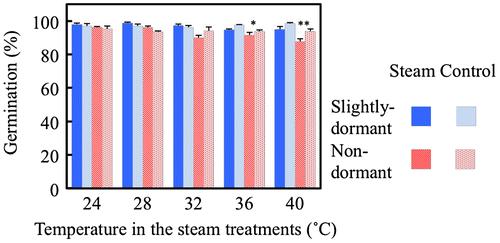
Figure 2. The 50% germination time (T50S, based on the number of seeds) of the slightly dormant and non-dormant seeds subjected to steam treatments using the steam cabinet for 7 d (Exp. 1). Untreated seeds were used as the control. Vertical bars indicate standard errors (n = 4). * and *** indicate significant differences between the steam treatment and the control for the slightly dormant and non-dormant seeds at p < .05 and .001, respectively (ANOVA).

The control, highly dormant ‘Takanari’ seeds, which exhibited a 23.5% germination percentage, were the most dormant among the three cultivars examined in Exp. 2 (Table , Figure ). The germination percentages increased with the steam and dry heat treatments for 5 and 7 d, respectively, but all the values were <90%. In particular, the 5-d steam treatments were less effective than the other treatments. The medium-dormant ‘Moeminori’ seeds exhibited the second highest germination percentage in the control tests. The steam treatments for ≥2 d and the dry heat treatment for 7 d increased the germination percentages of ‘Moeminori’ to ≥90%. The medium dormant ‘Hitomebore’ seeds were least dormant in Exp. 2, and all the treatments increased the germination percentage to ≥90%.
Figure 3. Germination percentage of the three cultivars subjected to steam treatments using the steam cabinet at 40 °C for 5 and 7 d (medium dormant ‘Hitomebore’ and highly dormant ‘Takanari’) and for 1–7 d (medium dormant ‘Moeminori’) and dry heat treatments at 50 °C for 5 and 7 d (Exp. 2). Vertical bars indicate standard errors (n = 4). Means followed by the same letters for each cultivar are not significantly different at p < .05 (Ryan’s method).
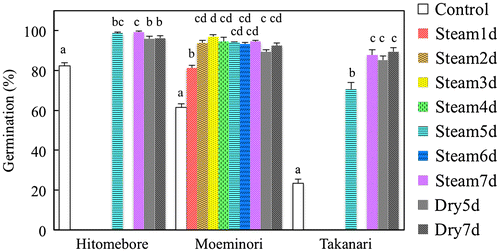
In ‘Takanari’ seeds, all the treatments decreased T50S, but the 5-d steam treatment was less effective (Figure ). All the treatments decreased the T50S of ‘Moeminori’ seeds, and the steam treatments for ≥3 d were more effective than the dry heat treatments. Among the steam treatments for ≥5 d, there were no significant differences in T50S. Similar to the results observed for the other cultivars, all the treatments decreased the T50S of ‘Hitomebore’ seeds, and the steam treatments were more effective than the dry heat treatments.
Figure 4. The 50% germination time (T50S; based on the number of seeds) of the three cultivars subjected to steam treatments using the steam cabinet at 40 °C for 5 and 7 d (medium dormant ‘Hitomebore’ and highly dormant ‘Takanari’) and for 1–7 d (medium dormant ‘Moeminori’) dry heat treatments at 50 °C for 5 and 7 d (Exp. 2). Vertical bars indicate standard errors (n = 4). Means followed by the same letters for each cultivar are not significantly different at p < .05 (Tukey’s method). NA: not available for control because the germination percentage was < 50%.

The seed moisture content of ‘Moeminori’ seeds increased with the duration of the steam treatments (Figure ). For instance, the seed moisture content increased by 1.3 and 1.5% for 5 and 7 d, respectively. In contrast, the 5-d dry heat treatment decreased the seed moisture content to 5.1%.
Figure 5. Moisture in ‘Moeminori’ seeds subjected to steam treatments at 40 °C using the steam cabinet and dry heat treatments at 50 °C (Exp. 2). Note that vertical bars are used to denote the standard errors. However, the depicted bars are smaller than the symbols used, so they are not clearly discernible. *** indicates significant differences between the two treatments at p < .001 (ANOVA).
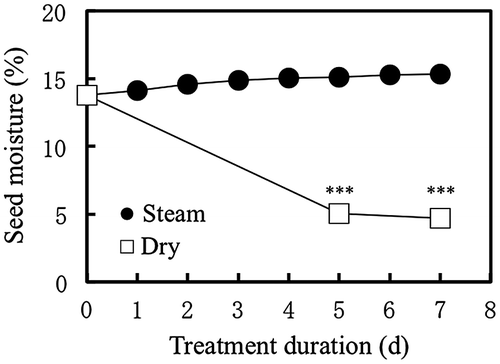
The germination percentage of the highly dormant ‘Takanari’ was increased to 98% or more with the steam treatments, which were more effective than the dry heat treatment for 7 d (Figure , Exp. 3). There was no significant difference in the effects among the steam treatments for 7 to 13 d.
The steam treatments for 7 to 11 d decreased T50S to <3 d, i.e. to the non-dormant level. The steam treatments for 7 d to 11 d were more effective than the dry heat treatment for 7 d.
The seed moisture was increased with the steam treatments (Figure ), whereas it was decreased with the dry heat treatment. However, there was no significant difference in seed moisture among the steam treatments for 7 to 13 d.
The germination percentage of the non-dormant ‘Moeminori’ was decreased by <5% following the 7-d steam treatment and the 5-d dry heat treatment (Figure , Exp. 4). The germination percentage of the non-dormant ‘Takanari’ was increased by <5% following the steam treatment for ≥1 d and the 5-d dry heat treatment.
All the treatments decreased the T50S of ‘Moeminori’ seeds by <.5 d (Figure ). None of the steam treatments decreased the T50S of ‘Takanari’ seeds. The 5-d dry heat treatment decreased the T50S of ‘Takanari’ seeds by <.5 d.
The seed moisture increased with the duration of the steam treatments (Figure ). The seed moisture in the case of the 5-d dry heat treatment was significantly lower than that in the 5-d steam treatment in both the cultivars.
Discussion
Based on our results, we concluded that the steam treatment using a steam nursery cabinet at 40 °C for 7 d is appropriate for the highly dormant seeds, and that the treatment for 5 d is appropriate for the less dormant seeds. Temperatures lower than 40 °C for 5 d or for a duration less than 5 d may also be sufficient. Moreover, the results indicated that steam treatment is not required for non-dormant seeds. The effects and necessity of the steam treatments and the appropriate conditions for each dormancy level are discussed below.
In the highly dormant ‘Takanari’ seeds, 7 d is sufficient for the steam treatment at 40 °C to break dormancy. The steam treatments at 40 °C longer than 7 d in Exp. 3 have not been examined for highly dormant seeds. It was observed that 7 d is enough to increase germination percentage (Figures and ). Also, it was found that 7 d is enough to decrease T50S (Figures and ). For the 7-d steam treatment, the average germination percentage was >90% and the average T50S was <3 d, which corresponds to the non-dormant level in Table . The 7-d steam treatment broke the dormancy as effectively as the 7-d dry heat treatment at 50 °C (Figures and ) or more effectively (Figures and ). This result is similar to that of CitationHoshina and Urano (2010), who reported that the germination percentage of ‘Hokuriku193’ increased from 47% to over 90% with 7-d steam treatment at 40 °C, and this treatment was more effective than the 7-d dry heat treatment at 55 °C. However, their results differed from ours, as they reported an increase in the germination percentage of ‘Takanari’ from 12% to only 60% by the same steam treatment, and that the treatment was less effective than the dry heat treatment. This discrepancy could have resulted because of the higher temperature used in their dry heat treatment and the stronger dormancy of their seeds. The indica cultivars (e.g. ‘Takanari’) sometimes exhibit dormancy levels that are so strong that their seeds hardly germinate, and so further effective steam treatments are required to break such extremely dormant seeds.
Figure 6. Germination percentage of highly dormant ‘Takanari’ seeds subjected to steam treatments using the steam cabinet at 40 °C for 7 to 13 d and dry heat treatments at 50 °C for 7 d (Exp. 3). Vertical bars indicate standard errors (n = 4). However, the depicted bars are smaller than the symbols used, so they are not clearly discernible. Means followed by the same letters for each treatment are not significantly different at p < .05 (Ryan’s method).
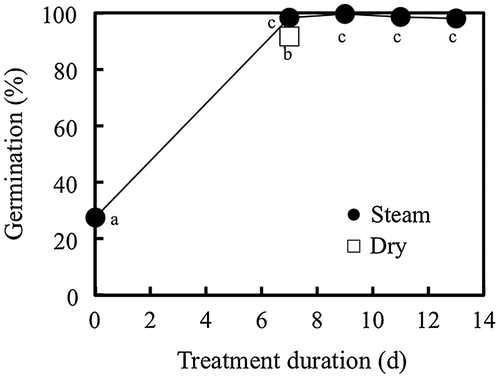
Figure 7. The 50% germination time (T50S; based on the number of seeds) of highly dormant ‘Takanari’ seeds subjected to steam treatments using the steam cabinet at 40 °C for 7 to 13 d and dry heat treatments at 50 °C for 7 d (Exp. 3). Vertical bars indicate standard errors (n = 4). However, the depicted bars are smaller than the symbols used, so they are not clearly discernible. Means followed by the same letters for each treatment are not significantly different at p < .05 (Tukey’s method). T50S of the control was not available because the germination percentage was < 50%.
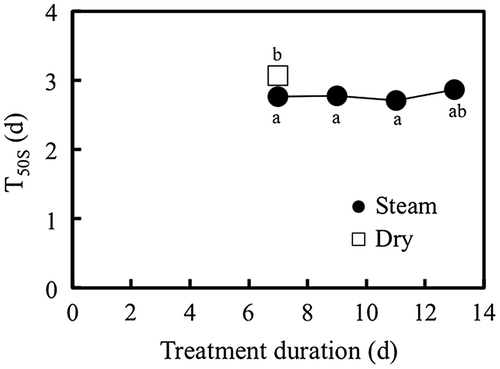
Figure 8. Moisture in ‘Takanari’ seeds subjected to steam treatments using the steam cabinet and dry heat treatments (Exp. 3). Note that vertical bars are used to denote the standard errors. However, the depicted bars are smaller than the symbols used, so they are not clearly discernible. *** indicates significant differences between the two treatments at p < .001 (ANOVA).
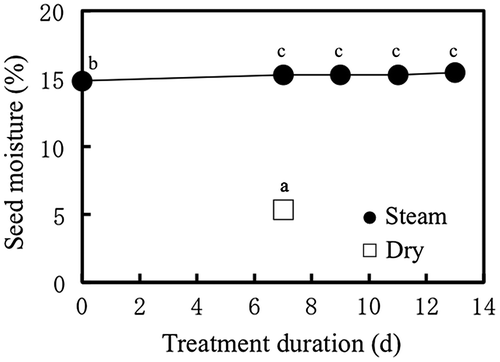
In the medium dormant seeds (‘Moeminori’ and ‘Hitomebore’) examined in Exp. 2, the 5-d steam treatment at 40 °C was enough to decrease T50S (Figure ). CitationYoshinaga et al. (2016) reported that for the medium dormant seeds of indica cultivar ‘Hokuriku193,’ 6 d was required to break the dormancy with steam treatment at 40 °C. The effect was better than the 7-d dry heat treatment at 50 °C (Figure ). Similarly, CitationKoide et al. (1988) reported that the 2-d treatment at 45 °C and 80% RH was more effective than the 7-d dry heat treatment at 55 °C, although the conditions used by them were slightly different from those used in the present study. In contrast, CitationYoshinaga et al. (2016) reported the dry heat treatment at 50 °C was more effective than the steam treatment at 40 °C. There may be difference in the effect of the steam treatment between japonica and indica cultivars, or among the cultivars, although the difference seems to be small. The difference of one day or longer in T50S at 30 °C between the 5-d steam treatment and the 7-d dry heat treatment may cause difference of two days or more in the seedling emergence under natural temperature. Rapid seedling emergence results in stable seedling establishment and easy weed control. The degree of dormancy is regarded as the practical upper limit of the japonica cultivars in Japan, because the ‘Moeminori’ seeds (the cultivar with high dormancy among the japonica cultivars) were tested within 3 months after the harvest. Consequently, the 5-d steam treatment at 40 °C was sufficient for the japonica cultivars in most cases. In addition to the germination percentage, T50S is an important metric used to investigate the dormancy-breaking treatments for medium dormant seeds. This is because T50S differed significantly between the steam and dry heat treatments, whereas the germination percentages were not significantly different.
In the slightly dormant seeds in Exp. 1, the steam treatment at temperatures ranging from 24 °C to 40 °C for 7 d decreased T50S (Figure ). These results were similar to CitationLee et al. (1998), who reported that the treatment at 25 °C and RH ranging from 40 to 80% for 7 d decreased T50. The results of our study suggested that dormancy could be broken using steam treatments at relatively low temperatures of ≤40 °C or at 40 °C for shorter durations. Therefore, because 5 d was sufficient for the medium dormancy seeds at 40 °C (Figures and ), treatment durations of ≤5 d might be sufficient for the slightly dormant seeds. Slight dormancy is thought to possibly correspond to the high dormancy of japonica cultivars at seeding during spring. This is because the ‘Moeminori’ seeds used in Exp. 1 were tested in February and March, which are a few months before seeding in the next year of the harvest. The steam treatment at temperatures lower than 40 °C or those with durations <5 d could be practical and sufficient for farming. The slight dormancy may not cause problems associated with the nursery boxes under controlled conditions, but it may affect germination and seedling emergence in direct seeding where seeds germinate under harsher conditions. Indeed, farmers sometimes found that seedlings of ‘Moeminori’ emerged later than those of ‘Hitomebore’ in direct seeding and considered it to be a problem. Seed hardening, which decreased the 50% seedling emergence time of the iron-coated seeds by about 1 d at 25 °C and about 2 d at 20 °C (CitationFuruhata et al., 2008), is practically used to promote seedling emergence in direct seeding of iron-coated seeds. This means the decrease in T50S by .77 d and 1.03 d with the 7-d steam treatment at 36 °C and 40 °C (Figure ) may be useful for slightly dormant seeds in direct seeding with iron-coated seeds.
In most cases in Exp. 1, the 7-d steam treatments at temperatures ranging from 24 to 40 °C did not have any useful effect on the germination percentage and T50S of non-dormant ‘Moeminori’ seeds, whereas the 7-d treatment at 40 °C decreased the germination percentage (Figures and ). In Exp. 4, the steam treatments for ≥1 d at 40 °C decreased T50S of non-dormant ‘Moeminori’ seeds significantly but slightly (by <.5 d) without any useful effect on the germination percentage (Figures and ). The steam treatments ≥1 d at 40 °C increased the germination percentage of the non-dormant ‘Takanari’ seeds significantly but slightly (by <5%); however, it did not significantly decrease T50S (Figures and ). The positive effects in Exp. 4 may result from longer T50S than those of the non-dormant control seeds in Exp. 1. However, the positive effects were so small that the steam treatments were, practically, unnecessary. These results suggested that the steam treatments were unnecessary for the non-dormant seeds, and might possibly be harmful.
Figure 9. Germination percentage of non-dormant ‘Moeminori’ and ‘Takanari’ subjected to steam treatments using the steam cabinet at 40 °C for 1–7 d and dry heat treatments at 50 °C for 5 d (Exp. 4). Vertical bars indicate standard errors (n = 4). Means followed by the same letters for each cultivar are not significantly different at p < .05 (Ryan’s method).
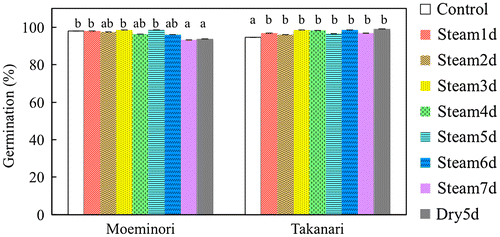
Figure 10. The 50% germination time (T50S; based on the number of seeds) of non-dormant ‘Moeminori’ and ‘Takanari’ subjected to steam treatments using the steam cabinet at 40 °C for 1–7 d and dry heat treatments at 50 °C for 5 d (Exp. 4). Vertical bars indicate standard errors (n = 4). Means followed by the same letters for each cultivar are not significantly different at p < .05 (Tukey’s method).
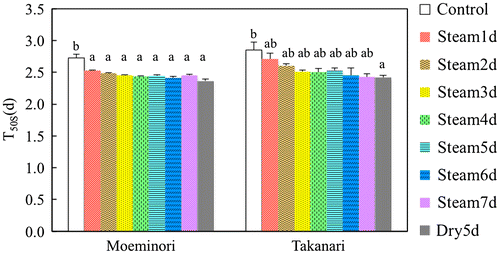
The steam treatment conditions were determined corresponding to the dormancy level of the seeds using the three cultivars. The dormancy level of the seeds examined almost covers the possible range of dormancy level of cultivars in Japan. However, there can be varietal difference in response to the steam treatment. Further study is required to elucidate the varietal differences using many varieties with different dormancy levels.
The seed moisture content increased slightly with the steam treatment, whereas a decrease in it was observed following the dry heat treatment (Figures , , and ). These results suggested that only slight increases in the seed moisture content were required to enhance the dormancy-breaking effects of high temperatures. This hypothesis was supported by CitationKoide et al. (1988) and CitationLee et al. (1998), who reported that treatments at <80% RH (lower than that used in the present study) broke the seed dormancy. Increase in seed moisture seems to accelerate aging and consequently serves to break the dormancy. However, the storability of the treated seeds needs to be investigated, because the high humidity and temperature treatments also promote seed aging (CitationKoide et al., 1988).
Figure 11. Moisture in non-dormant ‘Moeminori’ and ‘Takanari’ seeds subjected to steam treatments using the steam cabinet at 40 °C for 1–7 d and dry heat treatments at 50 °C for 5 d (Exp. 4). Note that vertical bars are used to denote the standard errors. However, the depicted bars are smaller than the symbols used, so they are not clearly discernible. *** indicates significant differences between the two treatments at p < .001 (ANOVA).
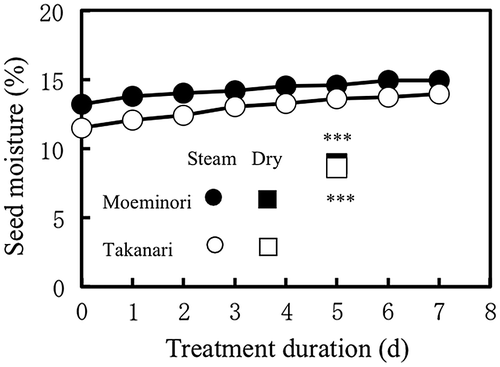
Steam treatment using the steam nursery cabinet is easy to adopt for many Japanese rice farmers, whereas the dry heat treatment is difficult to adopt, because most of them do not have large ovens. High-humidity treatments at <80% RH (CitationKoide et al., 1988; CitationLee et al., 1998) also require expensive apparatus to control humidity.
Our results indicated that steam treatments using a steam nursery cabinet are useful for breaking the seed dormancy of variously dormant seeds at a small scale. Larger scale treatments using mesh bags (5 kg seeds) have been developed (CitationShiratsuchi et al., 2011; CitationYoshinaga et al., 2016). Experiments with paper bags (20 kg seeds), which are used in farming in Japan, are necessary for their practical application in farming.
Funding
This work was supported by Ministry of Agriculture, Forestry and Fisheries of Japan Grant [Development of large-scale farming systems utilizing the information technology], [Development of crop production technology for all year round multi-utilization of paddy field].
Disclosure statement
No potential conflict of interest was reported by the authors.
References
- Farooq, M., Basra, S. M. A., Ahmad, N., & Hafeez, K. (2005). Thermal hardening: A new seed vigor enhancement tool in rice. Journal of Integrative Plant Biology, 47, 187–193. doi:10.1111/j.1744-7909.2005.00031.x
- Fukuda, A., Shiratsuchi, H., Yamaguchi, H., Ohdaira, Y., & Terao, T. (2013). Hot water treatment accelerates rice seed germination. The Hokuriku Crop Science, 48, 8–10*. Retrieved from http://ci.nii.ac.jp/els/110009985432.pdf?id=ART0010540776&type=pdf&lang=en&host=cinii&order_no=&ppv_type=0&lang_sw=&no=1485499777&cp=
- Furuhata, M., Chosa, T., Matsumura, O., & Yukawa, T. (2008). Effects of seed pretreatment on seedling emergence and establishment in iron powder coated rice. The Hokuriku Crop Science, 43, 19–12***. Retrieved from http://ci.nii.ac.jp/els/110007873199.pdf?id=ART0009548952&type=pdf&lang=en&host=cinii&order_no=&ppv_type=0&lang_sw=&no=1485499812&cp=
- Goto, A., Sasahara, H., Shigemune, A., & Miura, K. (2009). Hokuriku 193: A new high-yielding indica rice cultivar bred in Japan. Japan Agricultural Research Quarterly: JARQ, 43, 13–18. Retrieved from http://www.jircas.affrc.go.jp/english/publication/jarq/43-1/43-01-03.pdf10.6090/jarq.43.13
- Hayashi, M. (1986). Physiological studies on the relationship between levels of the endogenous germination inhibitors and the dormancy of rice seed. Bulletin of the Faculty of Agriculture, Kagoshima University, 36, 1–43**. Retrieved from http://ci.nii.ac.jp/els/110004993316.pdf?id=ART0008064854&type=pdf&lang=en&host=cinii&order_no=&ppv_type=0&lang_sw=&no=1485499881&cp=
- Hoshina, T., & Urano, K. (2010). Growth, yield and germination characteristics of super-high-yielding rice varieties. Report of the Chugoku Branch of the Crop Science Society of Japan, 51, 21–22****. Retrieved from http://ci.nii.ac.jp/els/110007818468.pdf?id=ART0009535594&type=pdf&lang=jp&host=cinii&order_no=&ppv_type=0&lang_sw=&no=1448787009&cp=
- International Seed Testing Association. (2006). This is a chapter. In ISTA (Ed.), International rules for seed testing: Determination of moisture content (pp. 9-1–9-8, 9A-1–9A-4). Bassersdorf: ISTA.
- Jennings, P. R., & Jesus Jr, J. (1964). Effect of heat on breaking seed dormancy in rice. Crop Science, 4, 530–533. Retrieved from https://dl.sciencesocieties.org/publications/cs/abstracts/4/5/CS0040050530?access=0&view=pdf
- Kapur, A., Kaur, J., & Sharma, H. L. (1987). Rice grain dormancy and its alleviation. IRRN, 12, 9–10. Retrieved from http://agris.fao.org/agris-search/search.do?recordID=PH8810465
- Kataoka, T., Yamaguchi, M., Endo, T., Nakagomi, K., Takita, T., Yokogami, N., & Kato, H. (2007). Development of a new rice variety “Moeminori” with high eating quality and adaptability to direct seeding. Bulletin of the National Agricultural Research Center for Tohoku Region, 107, 15–28**. Retrieved from https://www.naro.affrc.go.jp/publicity_report/publication/files/naro-se/tohoku107-2.pdf
- Koide, T., Ogino, I., & Shaku, I. (1988). Applying the accelerated aging treatment to break seed dormancy of rice. Research bulletin of the Aichi-ken Agricultural Research Center, 20, 77–82**. Retrieved from http://agriknowledge.affrc.go.jp/RN/2010402759
- Lee, S. S., Kim, J. H., Hong, S. B., & Yun, S. H. (1998). Effect of humidification and hardening treatment on seed germination of rice. Korean Journal of Crop Science, 43, 157–160. Retrieved from http://agris.fao.org/agris-search/search.do?recordID=KR1999000922
- Ohdaira, Y., Shiratsuchi, H., Yamaguchi, H., & Fukuda, A. (2014). Effects of cyanamide contained in lime nitrogen on seed dormancy and germination ability of rice (Oryza sativa L.). Japanese Journal of Crop Science, 83, 223–231*. doi: 10.1626/jcs.83.223
- Roberts, E. H. (1961). Dormancy in rice seed II: The influence of covering structures. Journal of Experimental Botany, 12, 430–448. doi:10.1093/jxb/12.3.430
- Shiratsuchi, H., Kitagawa, H., Okada, K., Nakanishi, K., Suzuki, M., Ogura, A., … Yasumoto, S. (2008). Development of rice “Seed-Mats” consisting of hardened seeds with a cover of soil for the rice transplanter. Plant Production Science, 11, 108–115. Retrieved from http://ci.nii.ac.jp/els/110006546695.pdf?id=ART0008528651&type=pdf&lang=en&host=cinii&order_no=&ppv_type=0&lang_sw=&no=1485499923&cp=10.1626/pps.11.108
- Shiratsuchi, H., Ohdaira, Y., Fukushima, A., Mochida, H., Fukuda, A., Yamaguchi, H., & Katayama, K. (2011). Breaking seed dormancy with a steam chamber in rice. Japanese Journal of Crop Science, 80, 188–189***. Retrieved from https://www.jstage.jst.go.jp/article/jcsproc/231/0/231_0_188/_pdf
- Takagi, Y., Samoto, S., Kishikawa, H., & Motomura, T. (1986). Effect of hydrogen peroxide on dormancy breaking in rice seed. Bulletin of the Faculty of Agriculture, Kagoshima University, 61, 55–59**. Retrieved form http://agriknowledge.affrc.go.jp/RN/2010360048.pdf
- Watanabe, K., Sato, H., & Sato, H. (1998). Effect of heat on breaking seed dormancy and its varietal differences in rice to germination 1. Varietal differences and condition of temperature to germination. Tohoku Agricultural Research, 51, 39–40***. Retrieved from http://agriknowledge.affrc.go.jp/RN/2010681490.pdf
- Yoshinaga, S., Furuhata, M., Heinai, H., & Ohsumi, A. (2016). Evaluation of the period for the breaking of seed dormancy using seedling incubator in high-yielding rice variety ‘Hokuriku 193. Hokuriku Crop Science, 51, 10–12***. Retrieved form https://www.jstage.jst.go.jp/article/hokurikucs/51/0/51_10/_pdf
- Zhang, X-G. (1990). Physiochemical treatments to break dormancy in rice. IRRN, 15, 22. Retrieved from http://books.irri.org/IRRN15no1_content.pdf